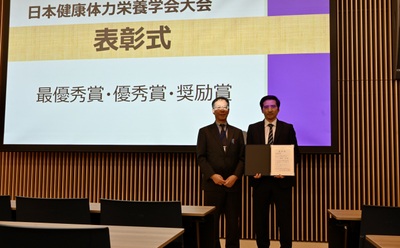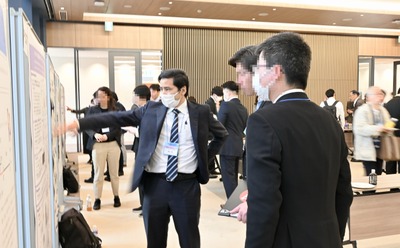JIU Josai International University

Associate Professor Ryo Kakinoki wins top award at the 32nd Japan Society of Health, Fitness and Nutrition Conference
teaching activity
2025.03.01
経営情報学部の柿木亮准教授は、3月1日に順天堂大学さくらキャンパス(千葉県印西市)で行われた第32回日本健康体力栄養学会大会おいて、「レジスタンス運動後のmTORシグナル活性化における筋線維組成の影響」の研究発表が評価され、最優秀賞を受賞しました。

Associate Professor Ryo Kakinoki (right)

Poster presentation
Research Summary
A skeletal muscle is mainly composed of two types of muscle fibers (slow and fast muscle fibers) mixed together in bundles, and it has been shown that muscle hypertrophy due to resistance exercise is more likely to occur in fast muscle fibers than in slow muscle fibers. However, the molecular mechanism behind this has not been fully elucidated. In this Research, we focused on the mTOR (mechanistic target of rapamycin) signaling pathway, which regulates protein synthesis in muscle cells, and used biochemical methods to analyze the activation of mTOR signaling in human skeletal muscles after a single resistance exercise at full strength. As a result, we showed that muscles with a higher proportion of fast muscle fibers had significantly higher mTOR signaling activation than muscles with a lower proportion of fast muscle fibers. This suggests that mTOR signaling is more likely to be activated in fast muscle fibers after resistance exercise, which may be one of the reasons why fast muscle fibers are more likely to hypertrophy.
<Characteristics of each muscle fiber>
Slow-twitch muscle fibers: Weak force, but sustained
Fast-twitch fibers: produce great force but fatigue easily
Comment from Associate Professor Kakigi
Skeletal muscles hypertrophy through training and atrophy if not used, so they play an important role in maintaining and improving general health and improving the performance of athletes. However, there are many unknowns about the molecular mechanisms behind this phenomenon of skeletal muscle adaptation. This Research is part of Research I conducted at my previous university, but I would like to further elucidate this mechanism through future Research, and contribute to the establishment of effective exercise training programs and the development of methods to prevent and treat muscle atrophy.